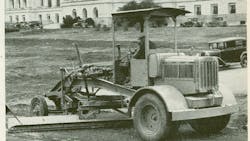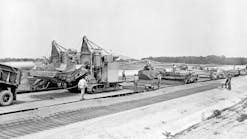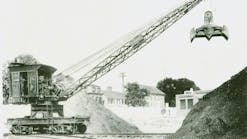The first rubber-tired, self-propelled, purpose-built motor grader was the Auto Patrol, introduced by Caterpillar in 1931. This machine embodied several major design breakthroughs. Rather than adapting a grader to a separate wheeled or crawler tractor, the grader and power unit were designed as a complete, integral unit, riding on a common frame on pneumatic tires with puncture-proof tubes.
Compared to a Motor Patrol, the operator’s station and the engine were essentially swapped. The engine was in the very rear of the machine, and the operator was positioned atop the frame, midway between the blade and the rear tires. He had a clear view down onto the blade, while the engine placement reduced its exposure to dirt and put more weight on the drive axle, resulting in more reliable operation and better balance. The powertrain was designed specifically to power the grader with the greatest possible traction, blade pressure, and stability. Moreover, the weight and positioning on the frame of the powertrain served to distribute weight across the front and rear axles and the blade, and the weights of the operator’s compartment, power control mechanism, and the blade and circle assembly were designed to produce maximum blade pressure, traction, and resistance to side thrust.
The Auto Patrol was the first motor grader to use power-operated blade controls, eliminating hand wheels and cranks and enabling smaller adjustments to be made more quickly. The controls were operated by a bank of levers: one to raise and lower each end of the blade, one to side-shift the circle, and one to turn the circle. A fifth lever raised and lowered the scarifier or a front V-snowplow. A drive shaft conveyed power from the engine flywheel to the central box via worm gears and a vertical shaft, bypassing the flywheel clutch and enabling the controls to be used whenever the engine was running. Inside the box, two gear trains distributed the power to the levers, which transmitted the power to the working parts through sliding jaw clutches, universal joints and telescoping shafts. The clutches would disengage at the limit of the working part’s motion, and the control levers returned to neutral when not in use.
The circle was rolled from angle steel, welded and machined to a true circle, and a length of high carbon steel was riveted around its front half to provide reinforcement. A set of screw clamps with lock nuts prevented vertical play and lost motion while allowing the circle to turn freely, and another set under the circle prevented lateral play. The circle was turned by a powered, self-locking worm gear with a brake that held the circle against back pressure caused by heavy loads on the blade. Although the circle and blade assembly was designed not to move under heavy load, a crossbar could be unbolted to allow the assembly to float more freely when working under light load at higher speed. A worm gear-driven side shift enabled the grader to trim shoulders, and blade end extensions further increased its reach.
Blade positioning along the length of the machine was determined by striking a balance, as it were, between the actions of the front and rear wheels. The further from the front axle, the less vertical motion would be imparted to the blade as the front wheels rolled over rough ground. The further from the rear axle, the less chance there was that the drive tires would be forced off the ground by down pressure on the blade. In the same manner, wheelbase length was an optimum between greater length to produce a smooth blading action while minimizing the effect of roughness in the road surface, and shorter length to provide for shorter turning radius.
For all its innovations, the Auto Patrol No. 9 was discontinued a year after introduction. Although motor grader design has evolved considerably since 1931, the basic concepts of the Auto Patrol are the standard of today’s graders.
About the HCEA
The Historical Construction Equipment Association (HCEA) is a 501(c)3 nonprofit organization dedicated to preserving the history of the construction, dredging, and surface mining equipment industries. With over 3,800 members in 25 countries, our activities include publication of a quarterly educational magazine, Equipment Echoes, from which this article is adapted; operation of National Construction Equipment Museum and archives in Bowling Green, Ohio; and hosting an annual working exhibition of restored construction equipment. Our next International Convention and Old Equipment Exhibition will be September 23-25, 2022, at the National Construction Equipment Museum in Bowling Green, Ohio. The HCEA is raising funds for construction of a new purpose-built building to house its equipment collection, and the Convention will feature groundbreaking for it. Individual annual memberships in the HCEA are $35 within the U.S. and Canada, and $55 elsewhere. We seek to develop relationships in the equipment manufacturing industry, and we offer a college scholarship for engineering and construction management students. Information is available at www.hcea.net, or by calling 419.352.5616 or e-mailing [email protected].





